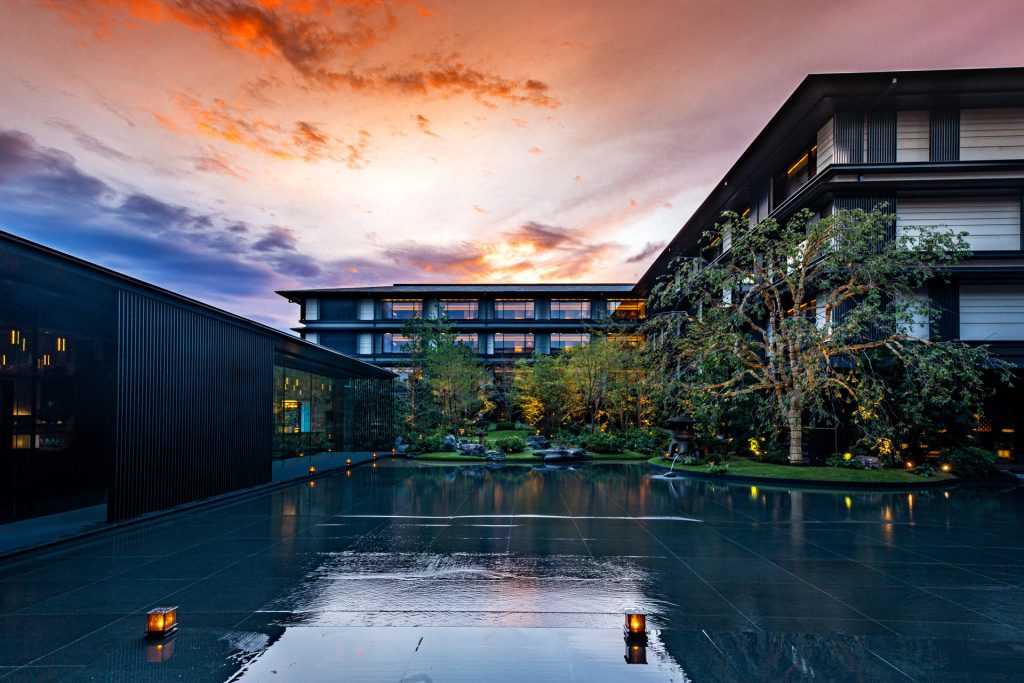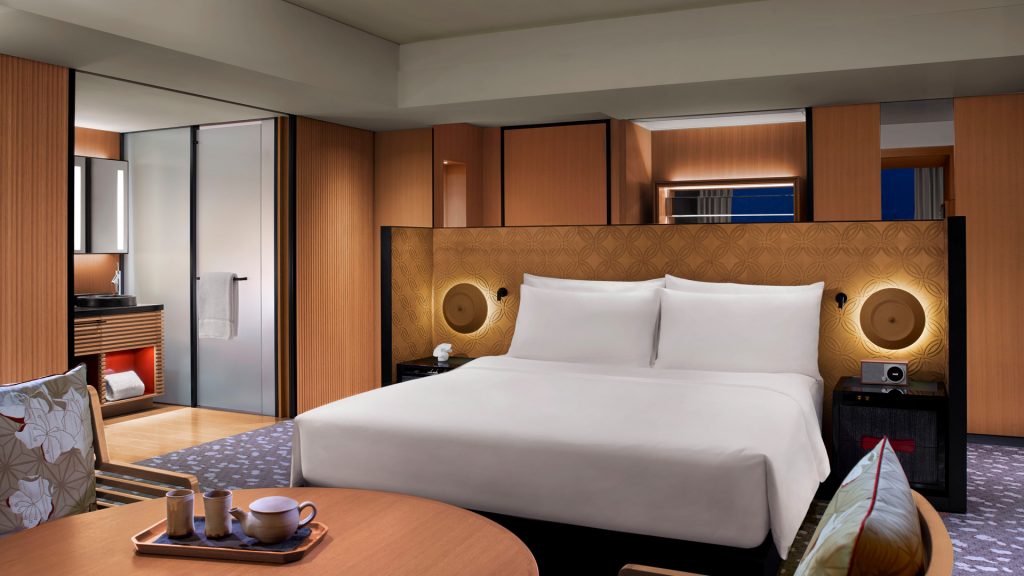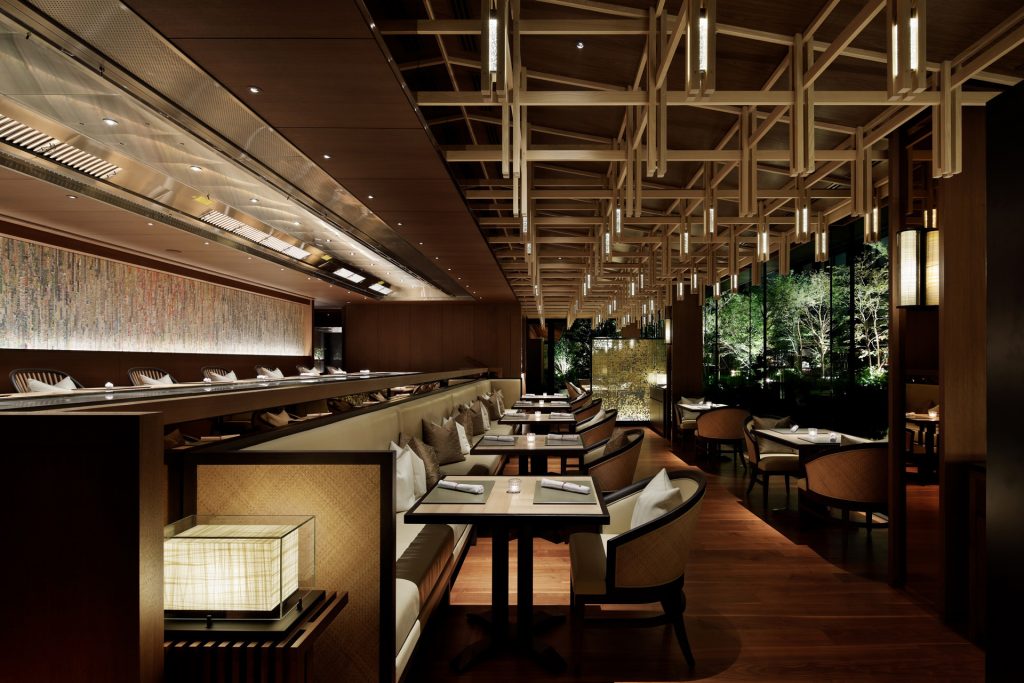THE EASTERN CAPITAL OF PEACE AND TRANQUILITY SHINES PARTICULARLY BRIGHT DURING CHERRY BLOSSOM SEASON
BY AMBER GIBSON
Kyoto was the capital of Japan for more than a millennium, from 794 to 1868, and still today shines as the country’s heart of cultural heritage, including art, architecture, kaiseki dining, and Buddhism. Kyoto was the only major Japanese city spared from bombing during World War II, preserving its UNESCO World Heritage temples, imperial palaces, and manicured gardens, along with its charming theaters and tea houses.

Spring cherry blossom (sakura) season is the most picturesque and popular time to visit, attracting a huge influx of domestic and international visitors. The first blossoms open in an effulgent explosion by the end of March, and the delicate pink and white petals are a world-famous symbol of fragile beauty, fluttering gracefully in the gentle breeze before falling like fragrant snow by the end of April. Autumn foliage is another brilliantly beautiful time to visit, but Kyoto’s grandeur and romance endure year-round.
KNOW BEFORE YOU GO
Kyoto doesn’t have an airport, so you’ll fly to Osaka, which is about 30 minutes away by train. You can also take a Shinkansen high-speed train from Tokyo to Kyoto, which takes a little more than two hours. Trains may be crowded, but they are orderly and quiet. Be respectful and don’t talk on the phone when taking public transport in Japan. The city is organized in a rectangular grid pattern, making it much easier to navigate compared to Tokyo.
Unlike in the United States, tipping is not expected or necessary, but do plan dining reservations well in advance. Ask your hotel concierge for help with more difficult reservations. Seasonality is the crux of Japanese cuisine and chefs in Kyoto have a reverence for nature, crafting multi-course meals that are a complex concinnity of peak season ingredients.
For a deeper understanding of Kyoto’s history and culture, book a customized trip with Inside Japan Tours. They’ll take care of your entire itinerary once you land in Japan, including airport transfers, for a seamless luxury experience. Knowledgeable and friendly guides are chosen to align with your interests, and Inside Japan can offer access to exclusive experiences and spaces that are not otherwise open to the public. Plus, the personalized tours can even be effortlessly adapted on the fly.
ATTRACTIONS
ARSHIYAMA BAMBOO GROVE
This iconic bamboo forest feels other worldly, with dappled sunlight filtering through the towering verdant stalks surrounding you. It’s easy to visit on your own, but a private guide from InsideJapan Tours will tell you about Nonomiya Shrine, where young maidens come to pray for love, and show you the best places to buy artisan bamboo crafts. Stroll to the villa at the top of the grove to enjoy a hot matcha tea with pan oramic views of Kyoto. Sagaogurayama Tabuchiyamacho, Ukyo Ward, insidejapantours.com
MIBU-DERA TEMPLE
One of the oldest Buddhist temples in Kyoto, Mibu-dera was formerly the headquarters of special police force Shinsengumi during Japan’s Edo period, many of whom are buried in the temple’s graveyard of patriots. Now Midu-dera is open to the public daily to tour the main hall, gardens, and shrines, and make a wish with Jizō Bosatsu, the guardian of children. In late April and October, you can catch a Mibu Kyogen performance, a traditional pantomime show accompanied by gongs, flutes, and drums that reflects Buddhist teachings and repels bad spirits. mibudera.com
WHERE TO STAY
SUIRAN, A LUXURY COLLECTION HOTEL, KYOTO
Serenity washes over you in the living room-like lobby at this rural bou tique hotel on the outskirts of Kyoto. Check-in with green tea and sweets as your luggage is immediately whisked away. With only 39 rooms, including four suites, Suiran has the understated elegance of a Japanese ryokan, with sliding doors and tatami mat floors, but modern Western comforts like plush beds, Toto toilets, and 24-hour room service. Many rooms have tranquil gardens and private onsen baths too, and if you do prefer a truly traditional experience, there’s one classic Ryokan-style room with twin futon bedding. Hinoki cypress oils and jade stones are used in indigenous spa treatments, with sacred water from Arashiyama hot springs flowing into open-air baths and therapists with strong hands kneading you right to sleep. 12 Susukinobaba-Cho, Saga-Tenryuji, Ukyo Ward, suirankyoto.com
HOTEL THE MITSUI KYOTO

Originally built in the late 17th century as a residence for one of the most powerful families in Japan, this 161-room hotel is located opposite the Nijo-jo Castle, fusing historic design principles with a sleek contemporary touch. Hong Kong’s André Fu designed the guest rooms and public spaces, working with Japanese architect Akira Kuryu. Bathe in natural thermal springs in the basement spa, where private onsens are available to rent, along with new facial and body treatments in partnership with Mikimoto Cosmetics that harness the power of rare pearl extracts to rejuvenate the skin for an ethereal glow. 284 Nijoaburanokoji-cho, Aburano-koji St. Nijo-sagaru, Nakagyo Ward, hotelthemitsui.com
THE RITZ-CARLTON, KYOTO

In the spirit of quiet luxury, this 134 room hotel feels authentically Japanese despite being a powerhouse global brand. Maybe it’s the tranquil location beside the Kamogawa River, or the impressive collection of modern Japanese artwork. Guests feel Kyoto’s distinctive and detail-oriented Japanese hospitality with each gesture, from the traditional tea ceremony at check-in to thoughtful turndown service. Visit the spa after a long flight for a deep release massage with heated bamboo sticks to elongate tight muscles, or a poultice massage infused with anti-oxidant rich green tea from Uji. Enjoy delicately fried tempura delights or lively teppanyaki followed by colorful macarons and entremets for dessert at one of the few Pierre Hermé Paris boutiques in Japan. Kamogawa Nijo-Ohashi Hotori, Nakagyo Ward, ritzcarlton.com/kyoto
DAY TRIPS AND TOURS
NARA PARK

Less than an hour away by train or car, Nara is located south of Kyoto and most famous for Todai-ji Temple, the world’s largest wooden building, and the 1,200 wild sika deer who are believed to be divine messengers of the Shinto gods. Nara Park is the best place to interact with these sacred deer, who will adorably bow to you in exchange for deer crackers made of wheat flour and rice bran. In mid-July, baby fawns are presented to the public at a special event called Kojika Koukai. A driver and guide from InsideJapan Tours can plan a seamless trip including pick-up from your Kyoto hotel. insidejapantours.com
ARIGATO TRAVEL FOOD & DRINK TOURS
Whether you prefer drinking sake or matcha green tea, touring a dynamic food market or snagging a seat at a secret kaiseki menu, the passionate guides at Arigato Travel will show you a side of Kyoto that isn’t normally accessible to tourists. On the sake and Japanese whisky nightlife cocktail tour, glimpse Kyoto’s famous geisha and maiko along quaint side streets (and learn how to tell them apart) between drinks at award winning cocktail bars where the pro prietors treat you like long lost friends. Most walking tours are family-friendly too, and kids 12 and under pay half price. arigatojapan.co.jp
DINE AND DRINK
TOKI

Parisian-trained Japanese chef Tetsuya Asano relies on Kyoto’s famously pristine water to make his simple but sublime dashi, which features prominently throughout his 12-course signature tasting menu. Many dishes pair a perfectly cooked protein with vegetables grown locally at Aoki Organic Farm, like red snow crab with taro or scallops with turnips. He even uses sake lees, a byproduct from brewing sake, to add a subtly sweet and fruity layer of flavor to butter as a perfect example of his signature Japanese French style. Asano is truly one of the most talented and technically precise chefs in Japan and will represent Japan at the 2027 Bocuse d’Or international culinary competition, the Olympics of cooking. 284 Nijoaburanokoji-cho, Aburano-koji St. Nijo-sagaru, Nakagyo Ward, hotelthemitsui.com
KAJI

Decor is minimalist but service is super warm at this intimate ten-seat restaurant that gives diners a front row show as their meal is prepared over an open charcoal fire. Chef Keone Koki’s Japanese-Peruvian heritage and California culinary training results in truly global fusion including dishes like quinoa Parmesan porridge with scallops and Peruvian pachamanca with Japanese sweet potato wrapped in kombu and Wagyu dressed in huacatay sauce. Beets, fish, and pineapple are all dry-aged and hearth cooked, resulting in deeper, richer flavors and textures. Even an American staple like Koki’s beloved Orange Julius is distinctly Japanese made with Mikan Mandarin oranges from Wakayama with creamy white chocolate and Sauternes jelly. 183-4 Fudocho, Nakagyo Ward, kajikyoto.com
TEMPURA MIZUKI
Throughout Japan, you’ll find many thriving restaurants that specialize in just one type of food, whether that’s sushi, yakitori, ramen, tonkatsu, or tempura. This laser focus allows chefs to master their craft and become the absolute best at what they do, which is certainly the case at Michelin-starred Tempura Mizuki within The Ritz-Carlton, Kyoto, where chef Taisuke Kojima serves the most delicately fried tempura at an eight-seat granite chef’s counter. Kojima uses gently pressed safflower oil to fry everything from okra, sweet potato, and eggplant to whole sweet prawns. Each bite has an ethereal crispness without any excess oil or grease. Fried food has never tasted this good, or this healthy. Kamogawa Nijo-Ohashi Hotori, Nakagyo Ward, ritzcarlton.com/kyoto


